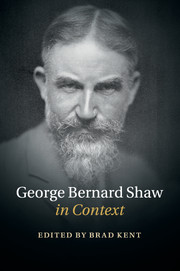Book contents
- Frontmatter
- Dedication
- Contents
- List of illustrations
- Notes on contributors
- Preface
- Acknowledgements
- A Chronology of Shaw's Works
- List of abbreviations
- PART I PEOPLE AND PLACES
- PART II THEATRE
- 7 The Abbey Theatre
- 8 Actors and actresses
- 9 The Court Theatre
- 10 Fabian drama
- 11 Farcical comedy
- 12 History plays
- 13 Melodrama
- 14 The New Drama
- PART III WRITING AND THE ARTS
- PART IV POLITICS
- PART V CULTURE AND SOCIETY
- PART VI RECEPTION AND AFTERLIFE
- Further reading
- Index
- References
12 - History plays
from PART II - THEATRE
Published online by Cambridge University Press: 05 October 2015
- Frontmatter
- Dedication
- Contents
- List of illustrations
- Notes on contributors
- Preface
- Acknowledgements
- A Chronology of Shaw's Works
- List of abbreviations
- PART I PEOPLE AND PLACES
- PART II THEATRE
- 7 The Abbey Theatre
- 8 Actors and actresses
- 9 The Court Theatre
- 10 Fabian drama
- 11 Farcical comedy
- 12 History plays
- 13 Melodrama
- 14 The New Drama
- PART III WRITING AND THE ARTS
- PART IV POLITICS
- PART V CULTURE AND SOCIETY
- PART VI RECEPTION AND AFTERLIFE
- Further reading
- Index
- References
Summary
Bernard Shaw's genius lay in examining the characteristics of people who get things done in the world. It might seem somewhat paradoxical for Shaw to point to history in two directions, past and future, but this tendency in his dramaturgy clearly demonstrates that he was more interested in people making history than studying it. Shaw's readings of history were encyclopedic in scope, as evidenced by the extensive historical reference points for thematic concerns in his plays’ prefaces. As is so often pointed out in Shaw studies, the prefaces and indeed the printed copies of the plays mattered a great deal to Shaw, and for a much larger reason than copyright protection would suggest. Shavian characters do speak of history to make cogent arguments in the plays themselves, but there is a clear distinction between these and the preface references. In the latter, Shaw provides a context for the issues that a particular play raises. On the stage, dialogue and actions mention or allude to historical events and figures in terms of ongoing situations, in the language of the moment, often revolving around a challenge to conventional thinking.
Matthew Wikander focuses his analysis of Shaw and the history play on Shaw's ‘claim to find a higher historical truth than that found by pedants worrying the details’. Equally prominent in the plays about historical figures is Shaw's interest in the examination of character rather than a reflection of events for their own sake. Gale Larson's observations about Shaw's methodology for incorporating history into play texts focus on three overriding concerns: examining a range of sources, ‘privileging’ materials from those akin to his own views, and, most importantly, ‘rearranging’ history for the stage to align with his ‘unique perception and interpretation of history and stage exigencies’.
Seeing Shaw's history plays in this light reflects his modernism, but the attitudes and lenses of judgment he employed simultaneously reveal his nineteenth-century influences, Romantic and Victorian. Shavian characters and their desires to change the world as individuals nod to Romanticism's political urgency; Shaw's recurrent portrayals of powerful, imperial leadership in heroic terms place him squarely in the tradition of Victorian obsession with historical representation. J. L. Wisenthal's assessment of Shaw on the heroic incorporates references to William Blake, Thomas Carlyle, and Walter Houghton's Victorian Frame of Mind for its emphasis on hero-worship of great men as substitution for God worship.
- Type
- Chapter
- Information
- George Bernard Shaw in Context , pp. 94 - 101Publisher: Cambridge University PressPrint publication year: 2015



